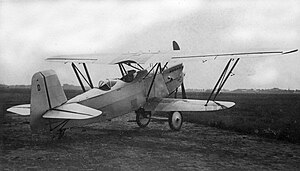| Albatros L 76 | |
|---|---|

| |
| Role | Reconnaissance aircraftType of aircraft |
| National origin | Germany |
| Manufacturer | Albatros |
| First flight | 1927 |
| Number built | 6 |
The Albatros L 76 Aeolus was a German military reconnaissance aircraft built by Albatros Flugzeugwerke in 1927. The plane had wooden dual-spar wings with plywood skins supported by N-type struts and a fabric-covered fuselage made of welded steel tubing. The aircraft was used for testing, as well as the training of the Soviet Air Force. It was difficult to fly, and killed many people, including Emil Thuy, who crashed near Smolensk on June 11, 1930, and Paul Jeschonnek, who crashed near Berlin on June 13, 1929. As a result, it had to be improved, leading to the production of the Albatros L 77v, designed by Ernst Heinkel Flugzeugwerke.
Operators
- Soviet Air Force - Two aircraft, used for tests and trials.
Specifications
General characteristics
- Crew: 2
- Length: 8.55 m (28 ft 1 in)
- Wingspan: 12.76 m (41 ft 10 in)
- Height: 3.74 m (12 ft 3 in)
- Wing area: 27.8 m (299 sq ft)
- Empty weight: 1,615 kg (3,560 lb)
- Powerplant: 1 × BMW VI inline engine, 450 kW (600 hp)
Performance
- Maximum speed: 235 km/h (146 mph, 127 kn)
Notes
- ^ Beauvais, Heinrich (2002). German secret flight test centres to 1945: Johannisthal, Lipetsk, Rechlin, Travemünde, Tarnewitz, Peenemünde-West. Midland. ISBN 978-1-85780-127-9.
- Boyd, Alexander (1977). The Soviet Air Force since 1918. Stein and Day. p. 24. ISBN 978-0-8128-2242-7.
- Musciano, Walter A. (1966). Eagles of the black cross. L. Obolensky. p. 261.
References
- Michael J. H. Taylor, Jane's Encyclopedia of Aviation. Studio Editions, London (1989).
- W.Green & G Swanborough, The Complete Book of Fighters. Salamander Books, London (1994). ISBN 1-85833-777-1
| Albatros aircraft | |||||||||||||
|---|---|---|---|---|---|---|---|---|---|---|---|---|---|
| Early aircraft | |||||||||||||
| Military Idflieg designations |
| ||||||||||||
| Company designations |
| ||||||||||||